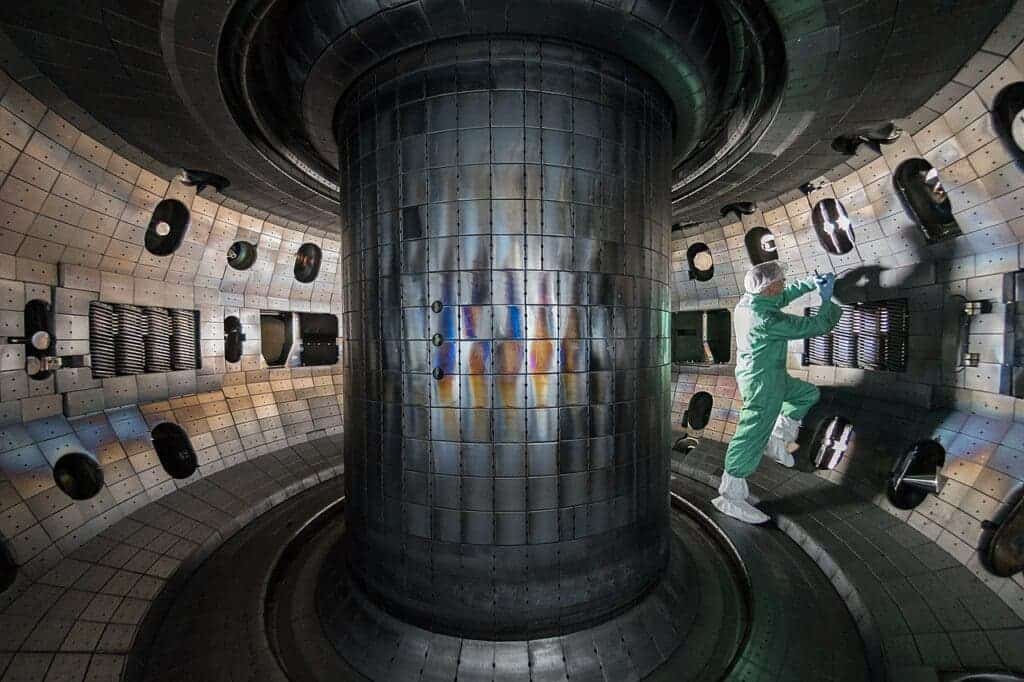
In fusion power, two atomic nuclei combine to form a heavier nucleus, releasing vast amounts of energy in the process. The process takes place in a fusion reactor and, at least in theory, this energy can be harnessed; but the practical aspects are extremely challenging.
An important problem for fusion reactors is maintaining the plasma core extremely hot (hotter than the surface of the sun), while also safely containing the plasma — something fusion researchers refer to as “core-edge integration”. Researchers working at the DIII-D tokamak at the National Fusion Facility managed to make the fusion core even hotter, while also safely cooling the material that reaches the reactor wall.
Somewhat like the conventional combustion engine, a fusion reactor must also exhaust heat and particles. A key strategy to cool down the plasma core is to inject impurities (particles heavier than the plasma) into the exhaust region — but these same impurities can travel into regions where fusion reactions are occurring , reducing overall performance.
Previously, these impurities were in the form of a gas. However, in a new study, researchers found that a particular chemical mixture in the form of a powder offers several advantages.
The powder consists of boron, boron nitride, and lithium, and it was trialed at the DIII-D tokamak reactor. A tokamak is a type of fusion reactor that uses magnetic fields in a donut shape to confine the plasma — something called a high-confinement mode, or H mode. Experiments showed that the powder was effective at cooling the plasma boundary while only producing a marginal decrease in fusion performance.
“Our work is important because it shows new ways to achieve high-pressure core plasmas (H-Mode and Super-H Mode) while keeping the boundary cold enough to avoid melting and damaging the reactor walls,” explains Florian Effenberg of Princeton Plasma Physics Laboratory, co-author of the new study “The injection of boron, boron nitride, and lithium powders into boundary plasma dissipates the power before it can reach wall components. Thereby, we can achieve both at a time, a super hot core plasma that can produce fusion energy and a cold boundary that allows safe and long-pulse operation of the reactor. “
Although the DIII-D is a relatively small tokamak, the experimental results along with theoretical simulations suggest that the approach is also compatible with larger devices like ITER, the international tokamak under construction in France, and would facilitate a core-edge integration solution in future fusion power plants.
“This is an important step integration solutions for safe heat exhaust and high-performance operation. Further assessments and optimization are, of course, necessary,” Effenberg concludes.
This approach could be instrumental in addressing the core-edge integration in future fusion power plants. So what does this mean for fusion power in general? It’s hard to make any clear estimates, says Effenberg, but the positive signs are there. The development of fusion reactors resembles that of microprocessors in computers. Just like there’s Moore’s law for microprocessors (which observes that the number of transistors in a microprocessor has doubled every two years) there’s a “Moore’s law for fusion”, in which the ‘triple product’ of density, temperature and confinement time (which measures the performance of a fusion plasma) has doubled every 1.8 years.
“Generally, we are on track and make progress according to “Moore’s law for fusion”, which shows that a demonstration fusion power plant is in reach within the next decade. The last meters are tough, but after a hunger period, there will finally be a wave of new and upgraded fusion machines coming online, flooding the last critical gaps in our knowledge with data,” Effenberg concludes.
Results will be presented at the 63rd Annual Meeting of the APS Division of Plasma Physics.









